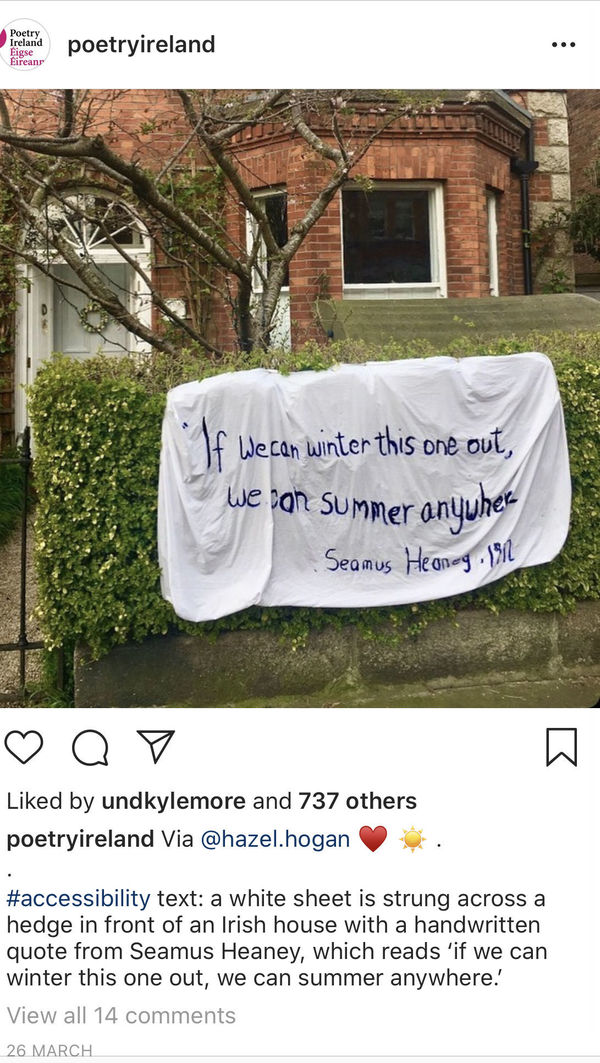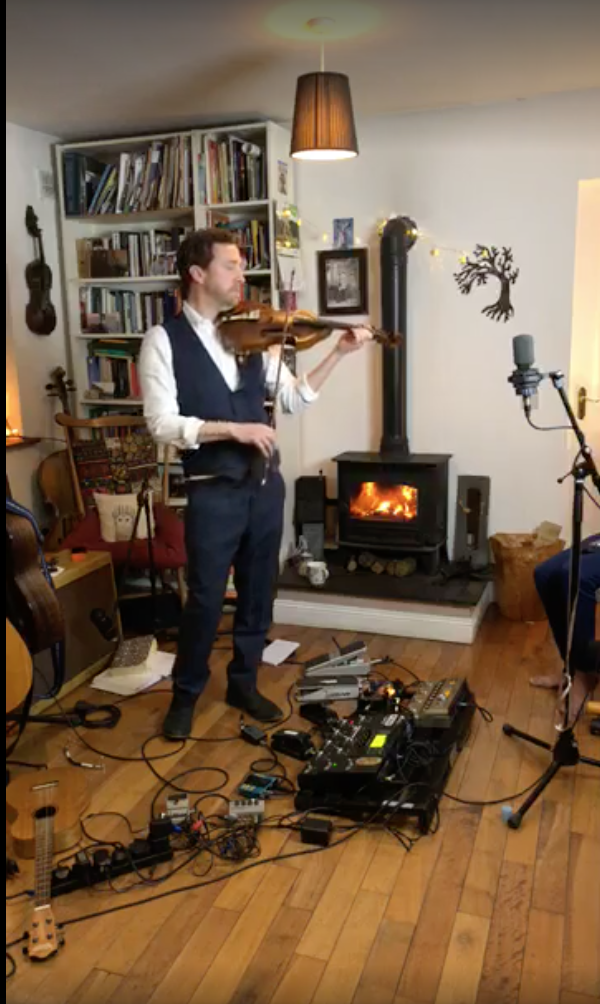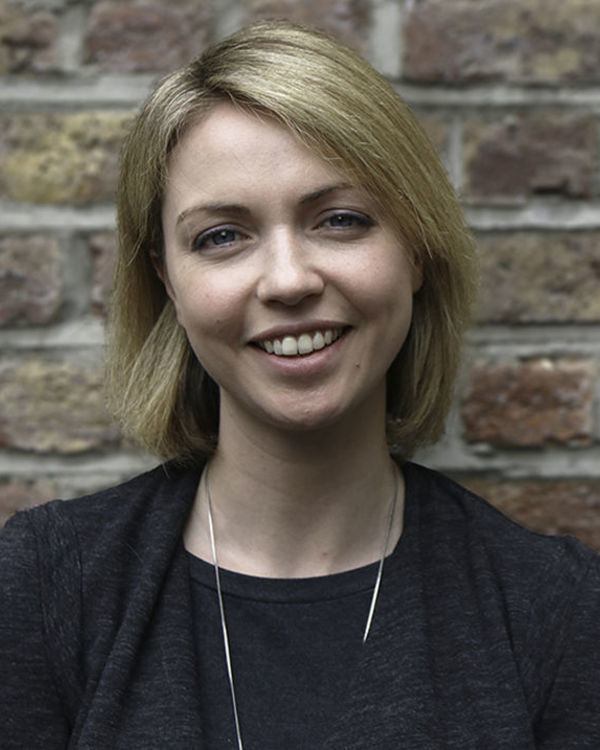The Arts in Ireland: The Massive Impact of COVID-19

In Ireland, March is the month during which street performers, marching bands, community groups and more see their year-long preparations coalesce to form a spectacular show for an audience typically 500,000 strong—the Dublin’s St. Patrick’s Day parade.
This year, on the 9th of March, the unprecedented decision was made to cancel the Dublin parade due to the Covid-19 pandemic. A few days later, An Taoiseach Leo Varadkar announced the closure of schools and third-level institutions in Ireland, the first in a series of restrictive measures aimed at preventing the spread of the disease.
As regulations tightened, the impact on the arts sector became more and more apparent. Theatres, concert venues, galleries, and national institutions all closed their doors overnight. Meanwhile, confined to their homes, people increasingly sought diversion, fulfillment, meaning and even possible futures in literature, music, art, film and television.
Arts and popular culture have enabled degrees of escape through the imagination for millions across the world as well as solace to quieten the mind in troubling times. In Ireland, the words of Seamus Heaney (1939-2013), who received an honorary degree from Notre Dame and had a longstanding affiliation with the University in Ireland and the US, are shared by thousands on social media providing comfort and hope: "If we winter this one out, we can summer anywhere."
In the U.S., Ambassador Daniel Mulhall has been reading poetry to his followers on social media—including work by Jane Clarke, James Joyce, and Patrick Kavanagh. Meanwhile bookshops adapt to an increase in demand for home deliveries and libraries increase their e-book holdings.

During the first weekend of social distancing, musician Colm Mac Con Iomaire mesmerised an online audience of 148,000 with one of his famed violin performances from his living room in Co. Wexford. A host of musicians followed suit including Northern Irish singer Gary Lightbody engaging his virtual audience in the creative process with “Saturday Song Write” sessions. The National Concert Hall’s “Me & My Instrument” initiative invites musicians to talk about their instruments in short videos as well as streaming short solo concerts.
Visual art lovers make do with livestreams of portrait painting hosted by the Royal Hibernian Academy and virtual tours and podcast series by the National Gallery of Ireland. The Irish Museum of Modern Art encourages their audience to share glimpses of their art and lives to help foster community during a time of isolation in addition to weekly activities for children.
As for the written word, certain literary events such as the annual Cúirt International Festival of Literature and Dublin One City One Book reimagined their programming to serve an online audience. Similarly, the Museum of Literature Ireland launched RadioMoLI on-demand, which hosts interviews, lectures, and readings with leading Irish authors. In Belfast, the Seamus Heaney Centre at Queen’s University has launched an inventive series called “Writers’ Rooms,” in which poets tell us how they are working and weathering the storm.
For some this crisis may be the mother of invention, but for the vast majority of the arts sector the situation poses an existential threat. While the efforts outlined above are laudable, online substitutions cannot replace the live experience. Restrictions on groups gathering in public spaces have impacted the theatre sector particularly hard. Overnight, practitioners saw months of hard work evaporate with little sign of when life would return back to normal. Thisispopbaby’s “Where We Live” series was launched and cancelled on the same day. While The Abbey Theatre is in a position to support initiatives such as “Dear Ireland” and to upload recordings of past performances online, smaller theatres will find it difficult to manage.
Early on, the arts community called on the Irish government to provide support for the sector. On the 3rd of April the Department of Culture & Heritage announced the Arts Council COVID-19 Crisis Response Award—a scheme “to support the creation of new artistic work and its dissemination online for the public benefit” as well as “Ireland Performs”— a collaboration between Culture Ireland and Facebook Ireland to provide awards for virtual performances to be distributed via social media channels. Initial reactions to these measures ranged from disappointment at the lack of engagement with artists and arts workers to anger at the perceived absence of understanding displayed by the Department as to how art is made and the conditions necessary for creative expression. Groups such as the National Campaign for the Arts and the Arts Blackout group were quick to voice concern. The Department’s short term approach is symptomatic of the uncertainty about the future with which people in every sector are grappling right now.
March is now over. Social distancing and quarantine measures continue through April. Will we see St. Patrick’s Day parades in March 2021? What damage will be done in the meantime? What effect will this all have on the cultural confidence of Ireland? How this period will be remembered and how it will be mediated, interrogated, and understood through the arts remains to be seen.
_____________________

Catherine Wilsdon is the Keough-Naughton Institute’s Dublin Programme Manager & Liaison. She holds a PhD in English Literature from University College Dublin, where her thesis focused on J.M. Synge’s travels in fin-de-siècle Europe. She held a number of research awards, including the Irish Research Council Postgraduate Award, the Irish Research Council New Foundations Award and the Fr. Liam Swords Foundation bursary at the Centre Culturel Irlandais, Paris. Dr. Wilsdon lectured in various Irish third level institutions before joining Notre Dame in 2017. She teaches Notre Dame students at O’Connell House and the National University of Ireland, Galway, as well as administering the Institute’s summer IRISH seminar and its Inside Track program.
Originally published by at irishstudies.nd.edu on April 29, 2020.